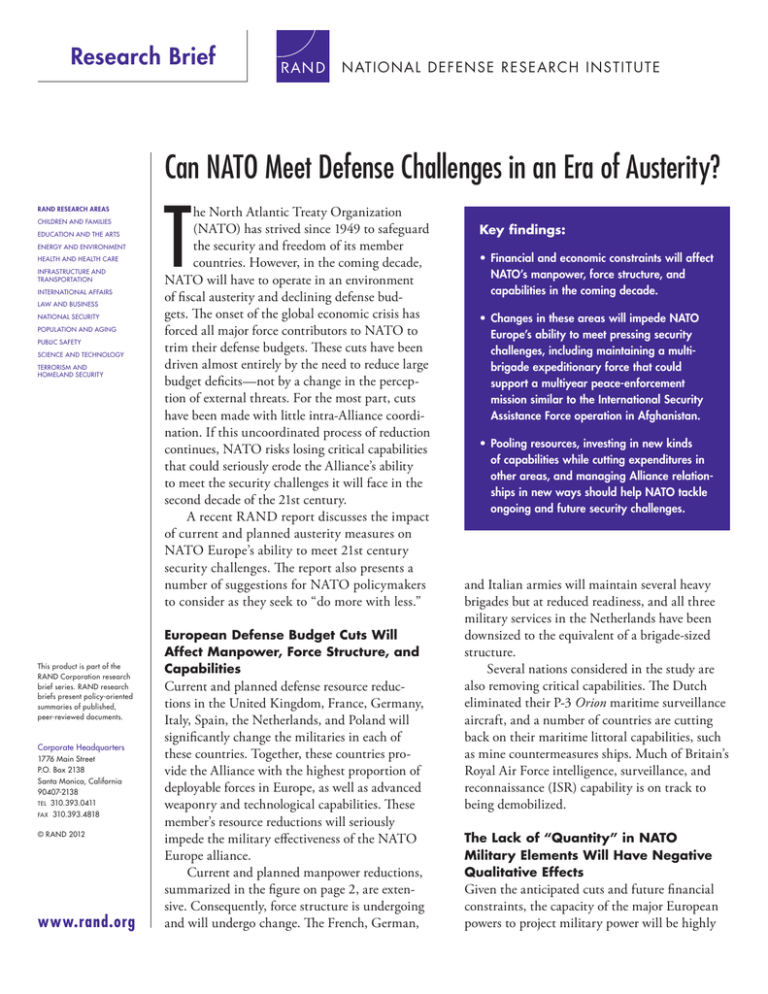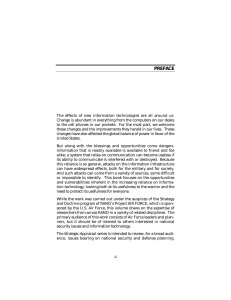T Can NATO Meet Defense Challenges in an Era of Austerity?
advertisement

Research Brief NAT I ONA L DE FE NSE R E SE A R CH I NST I T UTE Can NATO Meet Defense Challenges in an Era of Austerity? RAND Research areas Children and Families Education and the Arts Energy and Environment Health and Health Care Infrastructure and Transportation International Affairs Law and Business National Security Population and Aging Public Safety Science and Technology Terrorism and Homeland Security This product is part of the RAND Corporation research brief series. RAND research briefs present policy-oriented summaries of published, peer-reviewed documents. Corporate Headquarters 1776 Main Street P.O. Box 2138 Santa Monica, California 90407-2138 Tel 310.393.0411 Fax 310.393.4818 © RAND 2012 www.rand.org T he North Atlantic Treaty Organization (NATO) has strived since 1949 to safeguard the security and freedom of its member countries. However, in the coming decade, NATO will have to operate in an environment of fiscal austerity and declining defense budgets. The onset of the global economic crisis has forced all major force contributors to NATO to trim their defense budgets. These cuts have been driven almost entirely by the need to reduce large budget deficits—not by a change in the perception of external threats. For the most part, cuts have been made with little intra-Alliance coordination. If this uncoordinated process of reduction continues, NATO risks losing critical capabilities that could seriously erode the Alliance’s ability to meet the security challenges it will face in the second decade of the 21st century. A recent RAND report discusses the impact of current and planned austerity measures on NATO Europe’s ability to meet 21st century security challenges. The report also presents a number of suggestions for NATO policymakers to consider as they seek to “do more with less.” European Defense Budget Cuts Will Affect Manpower, Force Structure, and Capabilities Current and planned defense resource reductions in the United Kingdom, France, Germany, Italy, Spain, the Netherlands, and Poland will significantly change the militaries in each of these countries. Together, these countries provide the Alliance with the highest proportion of deployable forces in Europe, as well as advanced weaponry and technological capabilities. These member’s resource reductions will seriously impede the military effectiveness of the NATO Europe alliance. Current and planned manpower reductions, summarized in the figure on page 2, are extensive. Consequently, force structure is undergoing and will undergo change. The French, German, Key findings: • Financial and economic constraints will affect NATO’s manpower, force structure, and capabilities in the coming decade. • Changes in these areas will impede NATO Europe’s ability to meet pressing security challenges, including maintaining a multibrigade expeditionary force that could support a multiyear peace-enforcement mission similar to the International Security Assistance Force operation in Afghanistan. • Pooling resources, investing in new kinds of capabilities while cutting expenditures in other areas, and managing Alliance relationships in new ways should help NATO tackle ongoing and future security challenges. and Italian armies will maintain several heavy brigades but at reduced readiness, and all three military services in the Netherlands have been downsized to the equivalent of a brigade-sized structure. Several nations considered in the study are also removing critical capabilities. The Dutch eliminated their P-3 Orion maritime surveillance aircraft, and a number of countries are cutting back on their maritime littoral capabilities, such as mine countermeasures ships. Much of Britain’s Royal Air Force intelligence, surveillance, and reconnaissance (ISR) capability is on track to being demobilized. The Lack of “Quantity” in NATO Military Elements Will Have Negative Qualitative Effects Given the anticipated cuts and future financial constraints, the capacity of the major European powers to project military power will be highly –2– Current and Planned Manpower Reductions Will Deeply Affect NATO Europe Britain’s defense budget will be slashed by more than 8 percent until 2015; cuts could result in the loss of 42,000 personnel. The Netherlands has planned a 13 percent reduction in defense spending through 2015 that will lead to the loss of 12,300 personnel from its armed services. French officials in 2008 called for a 54,000person reduction in troop levels. The 2011 budget plan also called for an additional 3 percent cut to defense spending through 2013. Spain’s defense budget has been cut three separate times since 2008. These have involved major reductions in procurement, as well as a 7 percent cut in troop strength in 2011 and 2012. constrained. In light of these changes and NATO’s protracted large-scale counterinsurgency operations in Afghanistan, NATO Europe will not have the capability to maintain a multi-brigade expeditionary force over a long distance from Europe for a multiyear peace-enforcement mission. In the future, if UK and French forces were to become tied up in a protracted deployment along either the coast of Africa during a counter-piracy mission or while conducting a protracted peacekeeping operation in the sub-Saharan region, they would be strained to execute a time-urgent major Mediterranean expeditionary operation outside NATO. Conversely, if NATO Europe were to get involved in a major operation in the Mediterranean, it would not likely have the reserve capacity to address long-distance lower-risk contingencies, much less a higher-risk contingency in the Persian Gulf region. At best, the United States can hope that NATO Europe, including France, the UK, Italy, and Spain, might maintain a militarily credible Mediterranean capacity, with the understanding of the limits of that capability. Policy Recommendations In light of current and anticipated cuts, maintaining a viable Alliance defense posture that can ensure peace and security in the coming decade will pose a formidable challenge. A number of measures would help to strengthen NATO’s ability to meet this challenge: Encourage pooling and sharing resources. European governments have begun to pay greater attention to this idea as a means of compensation. However, while pooling and sharing can help to rationalize defense efforts and reduce Germany plans to cut $10 billion from its defense budget by 2013. This would reduce the size of its armed forces to 180,000 personnel—20 years ago, the German army alone had twice that many active duty soldiers. Poland stands out as the only country that has managed to increase its budget in recent years—by 7 percent in 2011, with a similar rise expected for 2012. Italy instituted a 10 percent cut in the Ministry of Defense’s budget in 2010, and officials are concerned that there may be additional cuts in 2013. costs, it cannot make up for sustained drops in defense spending. Bilateral partnerships, such as the British-French Defense Co-operation Treaty, may provide a more effective way of reducing costs and producing synergies. Promote leapfrogging. The strategy of “leap­frogging”— cutting defense expenditures heavily today while investing in new types of capabilities—may prove to be an effective way of coping with changing technological realities, emerging new threats, and declining defense budgets. Britain and the Netherlands appear to have chosen this path, rather than try to maintain old capabilities. Examine and adjust procurement priorities. European allies, especially Britain and France, need to put greater emphasis on ISR, suppression of enemy air defenses, aerial refueling, and increased stocks of precision-guided munitions. Participation in the Alliance Ground Surveillance (AGS) system should be sustained; if AGS dies and the ISRcapable UK Sentinel is terminated, NATO Europe’s aerial ground surveillance capability will be severely limited. Increase informal ad-hoc coalitions. NATO’s 2011 intervention in Libya demonstrated how the Alliance’s internal differences can make it difficult to agree to engage in missions beyond Europe’s borders. Coalitions of allies and partners may begin to operate outside the NATO context, as Britain, France, Qatar, and the United Arab Emirates did in the Libyan crisis. Consider engaging with the Maghreb in new ways. As the United States increasingly focuses on Asia, Washington should encourage NATO Europe to take lead responsibility for managing crises in the Maghreb—a region in which –3– Europe, especially the southern Alliance members, has strong historical interests. In this region, the United States would play a supporting role, providing key enablers to European allies who would have the lead in day-to-day combat missions. France, the UK, Italy, and Spain should consider assuming the primary responsibility for ensuring peace and stability in this region. Intensify defense cooperation between Britain and France. The United States should encourage Britain and France to intensify the defense cooperation initiated with the signing of the November 2010 defense treaty. This bilateral agreement is crucial to the effort of maintaining a carrier fleet that could assist the United States during any future containment strategy, including responding to Iran’s asser- tion of regional hegemony. This cooperation is all the more important because of the growth of Euro-skepticism within the Conservative Party and strong economic constraints on defense spending that the UK government will face. Encourage Germany to take greater responsibility for ensuring security and stability in Eastern Europe. Germany should be encouraged to maintain a robust ground force for this purpose. At the same time, Berlin should be encouraged to intensify defense cooperation with Poland within the framework of the Weimar Triangle and to work closely with Denmark and Sweden to ensure security of the Baltic region. Defense cooperation between NATO and Sweden and Finland should also be strengthened. ■ This research brief describes work done for the RAND National Defense Research Institute documented in NATO and the Challenges of Austerity, by F. Stephen Larrabee, Stuart E. Johnson, John Gordon IV, Peter A. Wilson, Caroline Baxter, Deborah Lai, and Calin TrenkovWermuth, MG-1196-OSD (available at http://www.rand.org/pubs/monographs/MG1196.html), 2012, 144 pp., $25, ISBN: 978-08330-6847-7. This research brief was written by Kate Giglio. The RAND Corporation is a nonprofit institution that helps improve policy and decisionmaking through research and analysis. RAND’s publications do not necessarily reflect the opinions of its research clients and sponsors. R® is a registered trademark. RAND Offices Santa Monica, CA • Washington, DC • Pittsburgh, PA • New Orleans, LA/Jackson, MS • Boston, MA • Doha, QA • Abu Dhabi, AE • Cambridge, UK • Brussels, BE RB-9675-OSD (2012) CHILDREN AND FAMILIES EDUCATION AND THE ARTS The RAND Corporation is a nonprofit institution that helps improve policy and decisionmaking through research and analysis. ENERGY AND ENVIRONMENT HEALTH AND HEALTH CARE INFRASTRUCTURE AND TRANSPORTATION This electronic document was made available from www.rand.org as a public service of the RAND Corporation. INTERNATIONAL AFFAIRS LAW AND BUSINESS NATIONAL SECURITY POPULATION AND AGING PUBLIC SAFETY SCIENCE AND TECHNOLOGY TERRORISM AND HOMELAND SECURITY Support RAND Browse Reports & Bookstore Make a charitable contribution For More Information Visit RAND at www.rand.org Explore the RAND National Defense Research Institute View document details Research Brief This product is part of the RAND Corporation research brief series. RAND research briefs present policy-oriented summaries of individual published, peer-reviewed documents or of a body of published work. Limited Electronic Distribution Rights This document and trademark(s) contained herein are protected by law as indicated in a notice appearing later in this work. This electronic representation of RAND intellectual property is provided for noncommercial use only. Unauthorized posting of RAND electronic documents to a non-RAND website is prohibited. RAND electronic documents are protected under copyright law. Permission is required from RAND to reproduce, or reuse in another form, any of our research documents for commercial use. For information on reprint and linking permissions, please see RAND Permissions.







